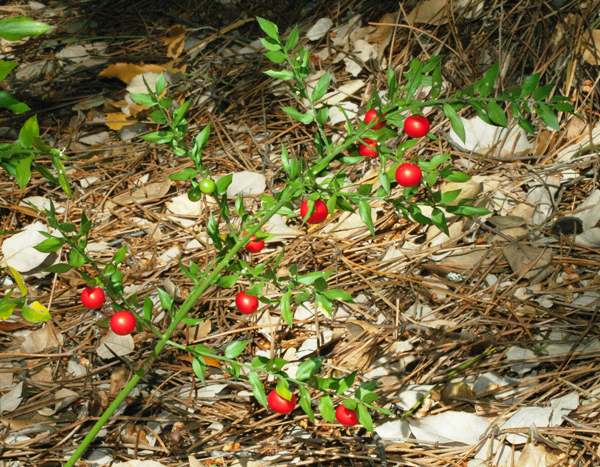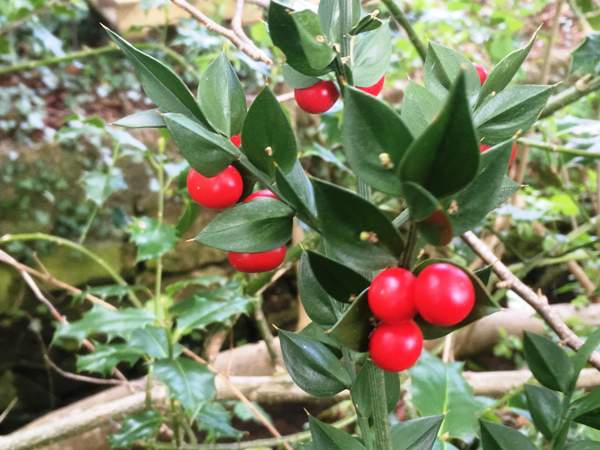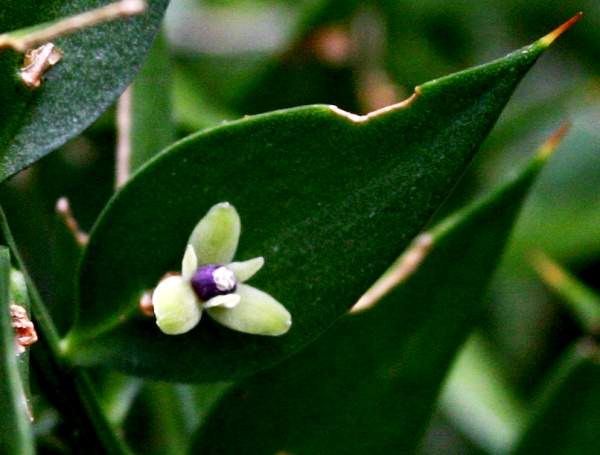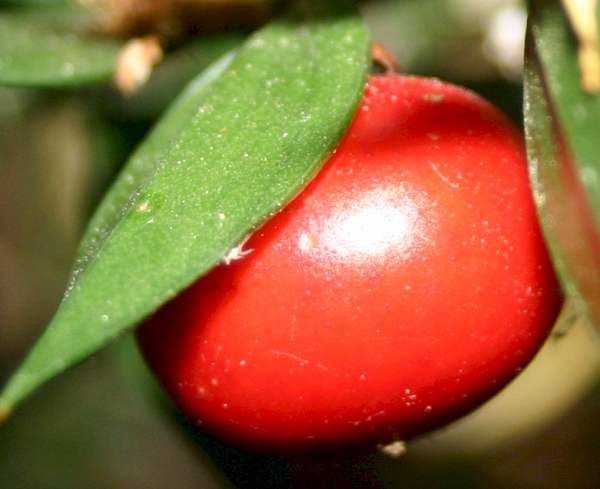Ruscus aculeatus - Butcher's Broom
Phylum: Magnoliophyta - Class: Equisetopsida - Order: Asparagales - Family: Asparagaceae

Above: Butcher's Broom in woodland in the Algarve region of Portugal.
A perennial evergreen shrub, Butcher's Broom is a very strange plant and not what it at first might seem to be. For a start, the large prickly 'leaves' are not really leaves at all; they are actually flattened branches referred to by botanists as cladodes (or sometimes as cladophylls), but they carry out the same function as leaves do on other plants. There are also very tiny true leaves at the base of each cladode, but you need to look very closely to see them at all. The stems and the cladodes are green, and they both contribute to photosynthesis. So this is a virtually leafless plant, and at first glance you might also think that it is flowerless, but look closely at the centre of the cladodes and you will see that some of them have tiny flowers growing there. The lovely red berries that cling to the centres of a small proportion of the cladodes are the fruits of the female flowers. Often you can find flowers and berries on the same plant, and always this is on a female plant because Butcher's Broom is dioecious: it produces male and female flowers on separate plants. Don't be surprised, therefore, if you also come across plants with no berries at all, as these are most probably male plants.
Description
This is such a distinctive plant that detailed description is hardly necessary for identification purposes; you will know it right away when you come across it (by sight, preferably, but if the woods are dark then maybe initially by feel!). The oval cladodes are typically 1.5cm across and 2.5cm long, each one terminating in a sharp spine. With three petals and three sepals, each of the greeny-white flowers is 3-5mm across, and when fully grown the fruit-bearing berries are about 1cm across.
Distribution
Native to Britain and Ireland, where it is the only monocot shrub, Butcher's Broom is most common in southern England and South Wales, but it is quite often found as far north as central Scotland. Most common in Mediterranean countries including northern Africa, Ruscus aesculus is also found in most central European countries.
Habitat
Favouring poor, dryish soils, Butcher's Broom copes well in drought conditions, and despite producing large, succulent fruits, it is remarkably tolerant of shade. Seed production, distribution and germination are reported to be very limited, and propagation is mainly reliant on vegetative spread via its stout rhizomes. This intriguing plant produces its tiny pale flowers from September onwards and they are fully open early in the New Year. Look out (closely!) for them from January through to the end of April. Green berries replace the female flowers and swell through the summer before turning bright red in autumn. The berries persist through to the following spring, but it is thought that few of them get dispersed to produce new plants. Fortunately, few animals enjoy eating Butcher's Broom, so plants do not need replacing very often. (Hermaphrodite forms of Ruscus aesculus have been cultivated, so that when you purchase a young plant from a nursery you can be confident of having the colourful berries once the plant matures.)

Above: Butcher's Broom, southern England, with mature berries on some cladodes and female flowers on others
Nearly always in woodlands but occasionally in well-shaded hedgerows, Butcher's Broom can grow to a height of a metre, but most plants are 50 to 80cm tall - knee height. That's why one of its other common names is Knee Holly. Ouch! Those points really are sharp.

Above: the tiny flowers of Butcher's Broom grow from locations near the centre of a small minority of the cladodes.
Uses
Bunches of branches of this tough plant were tied in bunches to make brooms with which butchers scrubbed their chopping blocks - hence the common name, of course. In the past various medicinal properties have been ascribed to plants of the Ruscus genus, of which six are known to occur in Europe. Scientific study has since shown that Butcher's Broom does indeed contain useful biochemical components including high concentrations of steroidal saponins, most particularly in the roots and rhizomes, as well as anthocynins that can be used in cancer treatment.

Acknowledgements
This page includes pictures kindly contributed by Simon Harding.